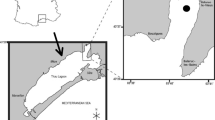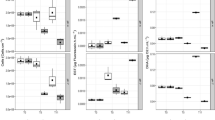Abstract
Kinetics of glucose and amino acid uptake by attached and free-living bacteria were compared in the upper 70 m of the oligotrophic north-western Mediterranean Sea. Potential uptake rates of amino acids were higher than those of glucose in all the samples analysed. Cell-specific potential uptake rates of attached bacteria were up to two orders of magnitude higher than those of total bacteria, both for amino acids and glucose (0.72–153 amol amino acids cell−1 h−1 and 0.05–58.42 amol glucose cell−1 h−1 for attached bacteria and 0.34–1.37 amol amino acids cell−1 h−1 and 0.07–0.22 amol glucose cell−1 h−1 for total bacteria). The apparent K m values were also higher in attached bacteria than in total bacteria, both for amino acids and glucose. These results would reflect the presence of different uptake systems in attached and free-living bacteria, which is in accordance with the different nutrient characteristics of their microenvironments, ambient water and particles. Attached bacteria show transport systems with low affinity, which characterise a bacterial community adapted to high concentration of substrates.
Similar content being viewed by others
Author information
Authors and Affiliations
Additional information
Received: 13 June 2000 / Accepted: 6 December 2000
Rights and permissions
About this article
Cite this article
Ayo, B., Unanue, M., Azúa, I. et al. Kinetics of glucose and amino acid uptake by attached and free-living marine bacteria in oligotrophic waters. Marine Biology 138, 1071–1076 (2001). https://doi.org/10.1007/s002270000518
Issue Date:
DOI: https://doi.org/10.1007/s002270000518




